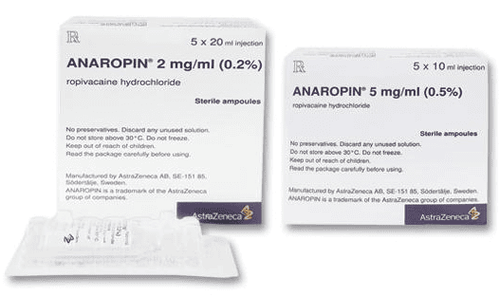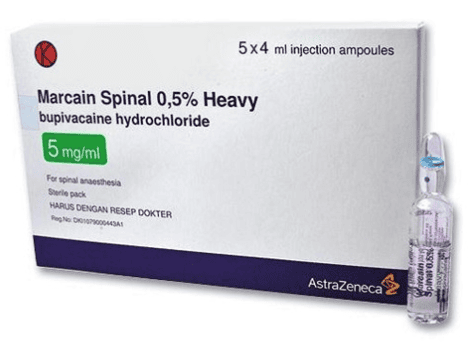This is an automatically translated article.
Ropivacaine belongs to the group of local anesthetics, also known as local anesthetics. The main ingredient is the active ingredient Ropivacaine also the name of the drug, Ropivacaine is used in anesthesia for surgery, acute pain relief in adults and children during and after surgery.
1. Uses of Ropivacaine
Ropivacaine belongs to the group of local anesthetics, with the main active ingredient being Ropivacaine. This active ingredient has a local anesthetic effect and relieves pain for a long time.Ropivacaine is prepared in the form of solution for injection 2mg/ml, 7.5mg/ml, 10mg/ml and solution for infusion 2mg/ml. Ropivacaine is indicated for use in the following cases:
Surgical anesthesia: Epidural anesthesia in surgery, including caesarean section; selective anesthesia; peripheral nerve blockade; major nerve blockade; intramedullary anesthesia. Acute analgesia: Intermittent high-dose Ropivacaine infusion or continuous epidural infusion for the purpose of analgesia after cesarean section or surgery; selective anesthesia; peripheral nerve blockade ; Continuous infusion or injection of intermittent peripheral nerve block for the purpose of managing acute pain after surgery. Acute pain relief in children during and after surgery: Selective anesthesia, peripheral nerve blockade in neonates and children under 12 years of age for postoperative analgesia. Continuous epidural infusion of ropivacaine, lumbar epidural block in neonates and children under 12 years of age for pain relief during and after surgery.
2. How to use and dose Ropivacaine
Ropivacaine is administered by infusion and anesthesia, anesthesia is carried out by medical staff or doctors. Care should be taken before and during injection to avoid injecting into a blood vessel by mistake. In the case of high doses of local anesthetics, a trial dose of lidocaine with adrenaline 3 - 5ml should be tested. If the wrong subarachnoid space or blood vessel is injected, the heart will beat faster or there will be spinal numbness.
Ropivacaine dosage will be customized according to the patient's condition. For anesthetics, it is best to use the lowest effective dose. Ropivacaine dosage in specific surgical anesthesia is as follows:
Back epidural: 15 - 20ml (7.5mg/ml or 10mg/ml solution). Chest epidural (postoperative block): 5 - 15ml (7.5mg/ml solution). Major nerve blockade: 30-40ml (7.5mg/ml solution). Regional anesthesia (subcutaneous injection): not to exceed 30ml (7.5mg/ml solution). Caesarean section: 15-20ml (7.5mg/ml solution). Ropivacaine dosage for pain relief is as follows:
Back epidural: 10 - 20 ml (2mg/ml solution), followed by 10-15ml (2mg/ml solution), each injection at least 30 minutes apart; or continuous epidural infusion 6 - 10ml/hour (2mg/ml solution) to relieve labor pain; or continuous epidural infusion of 6-14ml/hour (2mg/ml solution) for postoperative pain relief. Thoracic epidural anesthesia: Continuous infusion of Ropivacaine 6-14ml/hour (2mg/ml solution). Regional anesthesia (subcutaneous injection): Inject dose not exceeding 100ml (2mg/ml solution). Epidural analgesia in the sacral region in children over 1 year of age and weighing less than 25 kg: Inject 2mg/kg body weight (2mg/ml solution) to relieve pain before and after surgery). Overdose of Ropivacaine can cause symptoms such as hypotension, convulsions, coma, respiratory arrest, cardiac arrest. At that time, patients need respiratory support, intravenous fluids, intravenous thiopental 1-3mg/kg or diazepam 0.1mg/kg. If necessary, vasopressors can be used.
3. Ropivacaine side effects
Ropivacaine may cause some unwanted side effects such as skin rash, rash, sneezing, nausea, vomiting, dizziness, sweating, difficulty breathing, swelling of the face, mouth, tongue, and throat. .
Ropivacaine can also cause some serious side effects such as restlessness, anxiety, ringing in the ears, problems with vision or speech, tingling or numbness in the mouth, metallic taste, tremors, weak breathing or slowness, convulsions, weak pulse, slow or fast heartbeat, gasping for breath, unusual heat. At that time, the patient should immediately notify the doctor.
Some less serious side effects of Ropivacaine include headache, nausea, vomiting, fever, back pain, tingling, numbness, sexual function and urination problems.
For drugs in general, including Ropivacaine, if there is any abnormality, the patient should contact or notify the doctor immediately.
4. Some notes when using Ropivacaine drug
Do not use Ropivacaine in people who are hypersensitive to the ingredients of the drug or local anesthetics of the Amide group, who are hypovolemic. Do not use Ropivacaine in intravenous anesthesia, cervical anesthesia in obstetrics. Anesthesia in general and anesthesia with Ropivacaine in particular should be performed at medical facilities and medical staff with necessary equipment and drugs, in case an emergency occurs requiring resuscitation and follow. During injection, avoid injecting into infected areas. For epidural and intra-abdominal anesthesia procedures with Ropivacaine, caution should be exercised when hypotension and bradycardia occur. At this point, it is necessary to treat hypotension with intravenous vasopressors. For patients being treated with class III antiarrhythmic drugs who undergo anesthesia with ropivacaine, close monitoring with an electrocardiogram is required to prevent possible cardiac adverse effects. For a head-and-neck local anesthetic procedure, caution should be exercised because of the risk of serious side effects from the drug. When major peripheral nerve block is performed with Ropivacaine, it should be borne in mind that elevated plasma concentrations may be expected. Ropivacaine should be injected only in the absence of an alternative and safer in people with acute porphyria. Except for the case of using Ropivacaine for epidural injection during cesarean section, pregnant and lactating women should not use the drug because of limited research data. The ability to drive and use machines may be affected by the use of Ropivacaine in particular and local anesthetics in general, but it depends on the dose. Ropivacaine may increase the risk of systemic side effects when used concurrently with other local anesthetics, antiarrhythmics; increased risk of side effects from both drugs if taken with opioid pain relievers or anesthetics; reduced plasma clearance when co-administered with ketoconazole, a potent and selective inhibitor of CYP3A4. In all cases, in order to limit the interaction between drugs with Ropivacaine, it is best for the patient to provide a full range of drugs that have been and are being used, which must include prescribed or not prescribed drugs. dietary supplements and herbal products. Ropivacaine is used as an anesthetic during surgery, including caesarean section. In addition, Ropivacaine is effective in reducing acute pain in both children and adults, during and after surgery. Follow the website of Vinmec International General Hospital to get more health, nutrition and beauty information to protect the health of yourself and your loved ones in your family.
Please dial HOTLINE for more information or register for an appointment HERE. Download MyVinmec app to make appointments faster and to manage your bookings easily.













